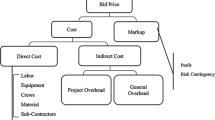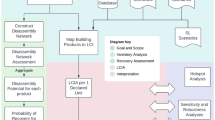Abstract
The steel fabrication and installation works in a steel-structured building project account for 20% of the entire construction cost. In estimating construction costs, a few parameters are more significant than work item productivity. However, the Standardized Productivity (SP) of steel works presented in Poom-Sam, which is the standardized estimating guide system used in the public sector in Korea, has rarely been updated since its establishment in the 1970s. In order to update and improve its structure and figures, 15 construction sites and 5 steel fabrication shops were visited over a period of two years. From the study, it was found that the structure of Poom-Sam was rather complex and outdated and that the average SP of the works analyzed from the research was approximately 85% of the current SP. Moreover, the effect of the productivity differences on total construction cost was approximately 10%. The productivity improvements and amended Work Breakdown Structure (WBS) are attributable to the technology advancements in equipment and construction methods over the past two decades. The results of this study will improve the reliability and accuracy of cost estimation in steel works.
Similar content being viewed by others
References
Allmon, E., Haas, C. T., Borcherding, J. D., and Goodrum, P. M. (2000). “U.S. construction labor productivity trends, 1970–1998.” J. Constr. Eng. Manage., ASCE, Vol. 126, No. 2, pp. 97–104.
Goodrum, P. M. and Haas, C. T. (2002). “Partial factor productivity and equipment technology change at activity level in U.S. construction industry.” J. Constr. Eng. Manage., ASCE, Vol. 128, No. 6, pp. 463–472.
Kim, B. (2008). “The contribution of innovation on productivity and growth in Korea.” J. Korea Technology Innovation Society, Vol. 11, No. 1, pp. 72–90.
Koch, J. A. and Moavenzadeh, F. (1979). “Productivity and technology in construction.” J. Constr. Div., ASCE, Vol. 5, No. 4, pp. 351–366.
Korea Institute of Construction Technology (2007). Standardized productivity of construction work (Poom-Sam), KICT, Korea.
Ministry of Land, Infrastructure, Transport and Tourism (2007). Standardized productivity of public building construction work for cost estimation (Bugakari), MLIT, Japan.
Niemelä, R., Routio, S., Hannula, M., and Reijula, K. (2002). “Work environment effects on labor productivity: An intervention study in a storage building.” Am. J. Ind. Med., Vol. 42, No. 4, pp. 328–335.
O’Connor, J. T. and Huh, Y. (2006). “Crew production rates for contract time estimation: beam erection, deck, and rail of highway bridges.” J. Constr. Eng. Manage., ASCE, Vol. 132, No. 4, pp. 408–415.
Oglesby, C. H., Parker, H. W., and Howell, G. A. (1989). Productivity improvement in construction, McGraw Hill, New York.
Park, H. S., Thomas, S. R., and Tucker, R. L. (2005). “Benchmarking of construction productivity.” J. Constr. Eng. Manage., ASCE, Vol. 131, No. 7, pp. 772–778.
Park, H. S. (2006). “Conceptual framework of construction productivity estimation.” J. Civil Eng., KSCE, Vol. 10, No. 5, pp. 311–317.
Proverbs, D. G., Holt, G. D., and Olomolaiye, P. O. (1999). “Productivity rates and construction methods for high rise concrete construction: A comparative evaluation of UK, German and French contractors.” Constr. Manage. and Econo., Vol. 17, No 1, pp. 45–52.
Sweis, G. J. (2000). Impact of conversion technology on productivity in masonry construction, PhD Dissertation, Northwestern Univ., Evanston, IL.
The Korean Government (2008). The act on contractors to which the government is a party, Ministry of Government Legislation, Korea.
Thomas, H. R., Riley, D. R., and Sanvido, V. E. (1999). “Loss of labor productivity due to delivery methods and weather.” J. Constr. Eng. Manage., ASCE, Vol. 125, No. 1, pp. 39–46.
Thomas, H. R. and Sanvido, V. E. (2000). “Role of the fabricator in labor productivity.” J. Constr. Eng. Manage., ASCE, Vol. 126, No. 5, pp. 358–365.
Waier, P. R., Babbitt, C., Balboni, T. B., and Bastoni, R. A. (2008). Means building construction cost data 2008, RS Means Company, USA.
Author information
Authors and Affiliations
Corresponding author
Rights and permissions
About this article
Cite this article
Yun, S., Cho, H., Tae, Y. et al. Productivity analysis of steel works for cost estimation of public projects in Korea. KSCE J Civ Eng 16, 1–7 (2012). https://doi.org/10.1007/s12205-012-0812-5
Received:
Revised:
Accepted:
Published:
Issue Date:
DOI: https://doi.org/10.1007/s12205-012-0812-5




